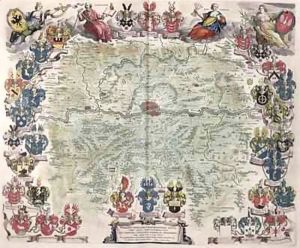Joan & Cornelius Blaeu Paintings
Joan Blaeu and Cornelis Blaeu were key figures in the world of cartography and publishing during the 17th century, hailing from the Netherlands, a country renowned for its contributions to the map-making industry of the time. Joan Blaeu was born in 1596 in Alkmaar, Netherlands, into a family already steeped in the art and science of map-making. His father, Willem Blaeu, was a prominent cartographer and instrument maker who had studied under the famous Danish astronomer Tycho Brahe. Cornelis, less well-documented than his brother Joan, was born in 1616 and played a significant role in the family business, although his contributions have been overshadowed by the expansive work of his brother.
Joan Blaeu became notably distinguished for his work in atlas production, eventually taking over the family business from his father. After studying law at the University of Leiden, he joined his father's workshop and quickly became an integral part of its operations. The Blaeu family business was renowned for its high-quality publications, including maps, atlases, and globes. In 1638, Joan Blaeu was appointed as the official cartographer of the Dutch East India Company, a position that allowed him unparalleled access to the latest geographic and hydrographic data from the company's exploratory voyages, significantly enhancing the accuracy and detail of his maps.
The Blaeu's magnum opus, the 'Atlas Maior', was published by Joan Blaeu in the mid-17th century and is considered one of the greatest achievements in the history of cartography. This monumental work, published in several volumes, contained detailed maps of the world as it was known at the time, with elaborate illustrations and geographical descriptions. Unfortunately, the Blaeu print shop in Amsterdam was destroyed by fire in 1672, resulting in the loss of many printing plates and unsold atlases, a significant blow to the Blaeu publishing empire.
Cornelis Blaeu's role in the family business, while significant, was largely eclipsed by the accomplishments of his brother Joan. Cornelis died in 1654, before the completion of the 'Atlas Maior'. Despite his earlier death, Cornelis contributed to the foundation upon which the success of the Blaeu publishing house was built, assisting in the production of numerous maps and atlases during his lifetime.
Joan Blaeu's death in 1673 marked the end of an era for the Blaeu family’s involvement in cartography and publishing. Despite the tragedies that befell the Blaeu print shop, the legacy of Joan and Cornelis Blaeu lives on through their contributions to the advancement of map-making and their pioneering work in the field of atlas production. Their maps and atlases remain highly prized by collectors and historians alike for their artistry, accuracy, and the insight they provide into the geographical understanding of the 17th century.
